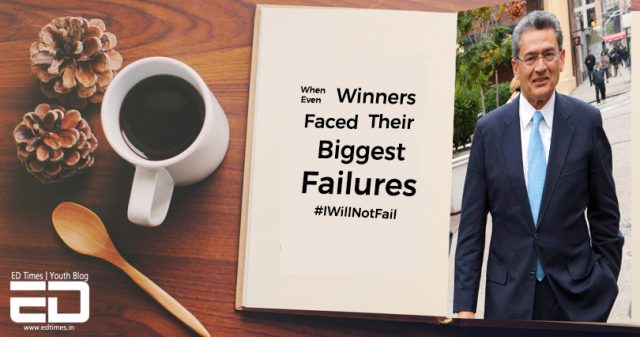Disclaimer: Originally published in June 2017. It is being republished since it still remains an interesting topic till today.
ED brings you a brand new ED Original Series: When Even Winners Faced Defeat, where you get a lesser-known narrative of inspirational people and the setbacks that came along their path.
So the next time you think that subject you didn’t get good marks in, or that person who didn’t like your picture on Facebook, and want to give up on life, then just take a look at these people who even after experiencing crushing defeats, came out as winners. Use it as your motivation, as your determination, because success does not come easy.
Hundreds of graduates each year are desperate to join Mckinsey & Co. One of the most lucrative companies.
But not many of these people know about the face of McKinsey in India. The man who guided the company through one of the most difficult periods for companies i.e. the dot-com boom, who grew McKinsey’s revenue by 280%.
The man who persevered through the tough times and always pushed forward. The man who fell and rose, Rajat Gupta.

Rajat Gupta was born in the idyllic streets of Calcutta to a teacher in a Montessori school and a journalist for Ananda Publishers. His father was incidentally also jailed but in the freedom struggle. And so the saga began.
At the age of 5, the family moved to Delhi, where his father found the Hindustan Standard. But, alas, tragedy struck Rajat at a very early age, the saga at the risk of ending prematurely.
His father died of tuberculosis that he had contracted during his time in prison (for the freedom struggle, irony?) and his mom passed away 2 years after that. Left alone, with his siblings, the gang decided to “live by themselves”.
Rajat Gupta went to school at Modern School and became somewhat of a Sharma Ji ka beta when he ranked 15th nationwide in the IIT JEE examination. After graduating from IIT-Delhi with a degree in Mechanical Engineering, he made a gutsy move in turning down ITC for a job, not an easy task.
True to his talent and skills, he went to Harvard Business School and graduated a Baker Scholar as an MBA. He then joined McKinsey, a pretty famous company in those days.
They initially rejected him, offering yet another obstacle in the path of this rising star, but one of Rajat’s professors in HBS intervened on his behalf. And as Yoda would say, continue, the saga did.
The years Rajat spent in McKinsey were those of frantic activity. Rising quickly despite assignments in less glamorous areas, Rajat became a senior partner in 1984 and the head of the Chicago office in 1990.
However, he was not yet done. In 1994, he became the managing director, shattering the glass ceiling and becoming the first Indian CEO of McKinsey.
He increased revenue, expanded to 20+ new countries and doubled the constant base. The orphan from Kolkata had finally reached. He had made it. He had overcome adversities and became a respected figure.
Adding on to that, he co-founded the Indian School of Business, which was ranked 13 globally in 2011. He also co-founded Scandent Solutions and The New Silk Route.
He also served on many high profile boards during his tenure. He was a member of Proctor and Gamble from 2007 to 2011 as well as a member of the board at Goldman Sachs from 2006-2010. Non-Executive Chairman of Genpact from 2007-2011.
He was also a big-time philanthropist, mainly in the areas of education, global health, and global business.
Read More: When Even Winners Face Defeat: The Narendra Modi Story
But alas, sagas such as Rajat Gupta’s rarely have happy endings.
Even though he had overcome many adversities to reach where he had, tragedy struck again.
On March 1, 2009, the SEC filed a civil complaint against Rajat for insider trading with Galleon Group founder Rajaratnam. Rajat’s friend and business partner, Anil Kumar had already pled guilty to the same.
But, it was in 2010, when the US Attorney’s office filed criminal charges against Rajat that this was taken to a whole new level.
Rajat’s story in the courts was hotly analyzed in the media. All his personal details discussed out in the open. His trial began on May 22, 2012. He was found guilty of 4 charges out of a total of 6 on June 15th, the same year.
As it is said, when it rains it pours. The maximum sentence for Rajat’s offense was a combined total of 25 years. At the end, Rajat was sentenced to two years of jail time. All his appeals were junked.
And serve the sentence he did, for two long years. Blotting his colourful resume with a dark, irremovable mark. But as always, Rajat was quick on his feet and made the best of the situation. It was not the best of times for him, but he survived.
He did not bow down to the judgemental society around him who branded him a felon and an outcast the moment he was convicted. He didn’t deter when even McKinsey distanced itself from him.
He persevered and was released from prison in January 2016, after which was on house arrest and then a supervised release.
Right now, Rajat is testing the waters. He was welcomed with open arms by the financial capital and has already started making new friends and getting back in touch with old ones. He wrote an article for Economic Times about the state of the Indian IT industry.
He is also working hard to overturn his conviction by proving that he received no tangible benefits from the act that he was convicted for.
Needless to say, Rajat’s story is one of Success to failure to Sucess. He has overcome adversities left and right and has survived and excelled.
Sources: India Today, The Hindu































